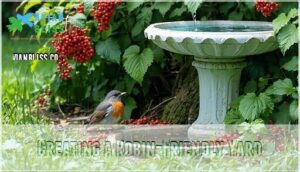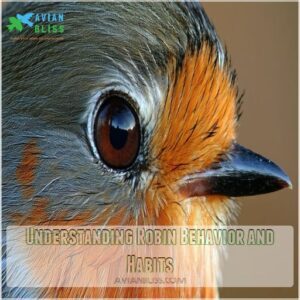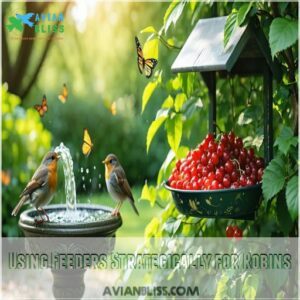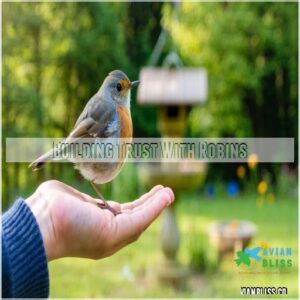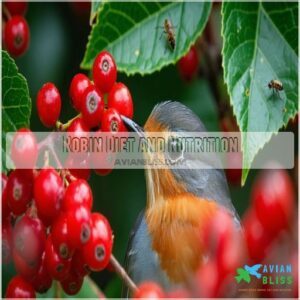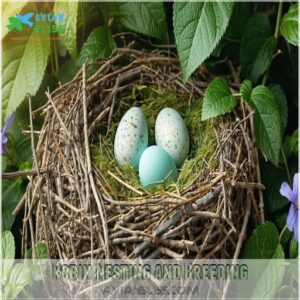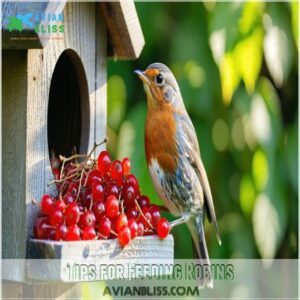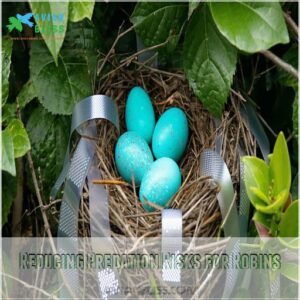This site is supported by our readers. We may earn a commission, at no cost to you, if you purchase through links.
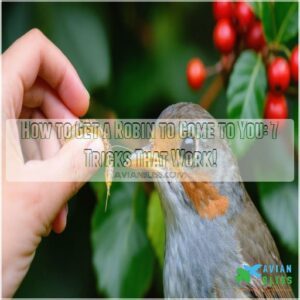 If you’re wondering how to get a robin to come to you, start by making your space irresistible to them.
If you’re wondering how to get a robin to come to you, start by making your space irresistible to them.
Place a shallow birdbath—about 10-12 inches wide—for easy access to water.
Robins love snacking on mealworms, fresh fruit, and insects, so offer a mix of these on a sturdy, flat feeder or even directly on the ground.
Choose berry-producing shrubs or native plants to turn your yard into a natural buffet.
Be patient and consistent; once robins feel safe and fed, they’ll often come closer. And who knows? With time, they might even eat right from your hand!
Table Of Contents
- Key Takeaways
- Creating a Robin-Friendly Yard
- Understanding Robin Behavior and Habits
- Attracting Robins With Food
- Building Trust With Robins
- Robin Diet and Nutrition
- Robin Nesting and Breeding
- Robin Fledglings and Care
- Tips for Feeding Robins
- Creating a Safe Environment for Robins
- Frequently Asked Questions (FAQs)
- How do you deal with Robins?
- How do you attract robins to your yard?
- How do you attract robins in winter?
- How do I become friends with Robins around my house?
- How do I get rid of Robins in my yard?
- How do I get Robins to nest in my yard?
- How do I get a robin to come to me?
- How to make robin come to you?
- How to befriend a robin bird?
- Can a robin recognize a human?
- Conclusion
Key Takeaways
- Set up a shallow birdbath with fresh water and keep it clean and accessible to attract robins.
- Offer mealworms, fresh fruits like blueberries, and suet in shallow feeders or directly on the ground near their habitats.
- Plant native berry-producing shrubs like serviceberry, holly, or juniper to provide a natural food source and shelter.
- Be patient and consistent, avoid sudden movements, and gradually sit nearby while providing food to build their trust. Attract robins by following these steps for natural food sources.
Creating a Robin-Friendly Yard
Want to transform your backyard into a robin’s paradise?
By creating a welcoming habitat with native plants, water sources, and thoughtful food offerings,
you’ll soon have these charming birds flocking to your outdoor space.
Providing a Water Source for Robins
Want to roll out the welcome mat for robins? Your secret weapon is a pristine water source.
Create a shallow birdbath—no deeper than 3 inches—positioned near shelter.
Keep it clean and fresh, especially during winter. A 10-12 inch diameter works best, offering robins a perfect spot to drink and splash, transforming your yard into their personal oasis.
Planting Berry-Producing Trees and Shrubs
After setting up your birdbath, ramp up your robin welcome mat by planting native berry-producing trees like Eastern Red Cedar and elderberry.
These birds also enjoy high-sugar fruits from Cedar Waxwings' favorites.
These strategic shrubs offer year-round food and shelter, transforming your yard into a robin paradise.
Offering Food for Robins
Transforming your yard into a robin’s paradise starts with strategic food placement.
Scatter mealworms, sprinkle fresh blueberries, and hang suet near water sources.
These protein-packed treats will turn your garden into a robin’s favorite dining spot, inviting these feathered friends to feast.
Understanding Robin Behavior and Habits
Robins are friendly, confident birds.
They’ll quickly capture your attention with their bold ground-feeding behaviors and curious nature.
Understanding their habits and preferences will help you create an inviting environment.
This will make these charming feathered friends feel right at home in your yard.
Robin’s Friendly and Confident Nature
Once you’ve created a robin-friendly environment, you’ll notice their confident nature shining through. These little feathered neighbors love human-bird interaction and aren’t shy.
Here’s what to watch for: Robin behavior is naturally bold, making this interaction incredibly rewarding—and sometimes amusing—as they "claim" their space!
- They’ll start approaching, curiously observing your activities.
- You might see them hopping nearby, almost as if they’re supervising.
- Over time, they can go beyond observing and accept hand-feeding.
Confident nature, human-bird interaction, hand-feeding, approaching.
Ground Feeding Habits of Robins
Robins are natural ground feeders, skilled at worm hunting and foraging for insects. Their favorite spots often include lawns or damp soil. Provide safe feeding zones and watch their fascinating behaviors while they explore.
| Robin Foraging Techniques | Preferred Ground Foods | Ground Feeder Safety |
|---|---|---|
| Scratching and hopping | Worms | Keep predators away |
| Picking through soft soil | Beetles and grubs | Use open, clear spaces |
| Focused surface hunting | Spiders and insects | Avoid pesticides nearby |
Preferred Ground Foods include worms, beetles, grubs, spiders, and insects.
Ground Feeder Safety requires keeping predators away, using open, clear spaces, and avoiding pesticides nearby.
Robin’s Nesting Preferences
Pick a nest box size with an open front and place it low—no higher than 2 meters.
Good nesting sites stay concealed, surrounded by shrubs, and face northeast to shield robins from rain.
Attracting Robins With Food
If you want robins to visit, offering the right food is key.
Mealworms, fresh fruit, and suet can turn your yard into their favorite hangout spot, especially during the colder months.
Offering Live Mealworms and Fresh Fruit
Treat robins like royalty with these irresistible snacks: live mealworms and juicy fresh fruits.
Here’s how to prepare the perfect robin feast:
- Experiment with mealworm varieties.
- Pick their favorite fruits: apple slices, strawberries, grapes.
- Match feeding frequency to demand.
- Offer seasonal treats (berries or live insects).
- Use small portion sizes to avoid waste while keeping robins satisfied.
Using Feeders Strategically for Robins
Robins are picky about feeder placement.
Set shallow trays or fruit feeders 2-3 feet high, close to a water source.
Keep feeders clean for healthy bird food.
Use this table for quick tips:
| Feeder Type | Placement | Height |
|---|---|---|
| Shallow Tray | Near Water | 2-3 Feet |
| Fruit Feeder | Bushy Habitat Edge | 2-3 Feet |
Supplementing Natural Food Sources
Don’t stop at feeders—mix up robin food with natural snacks! Winter food choices like mealworms, fruit variety (apples, berries), suet benefits, and a touch of peanuts make robins feel at home. Avoid offering bread for robins as it lacks essential nutrients for their diet.
- Top picks: Berries, apples, and mealworms
- Winter must-haves: Mealworms or suet for warmth
- Limit peanuts: Too many harm small birds
- Serve it right: Use shallow trays, not seed-based feeders
Building Trust With Robins
Earning a robin’s trust takes patience, consistency, and a calm approach.
By understanding their habits and offering them a safe, welcoming space, you’ll make it easier for them to see you as a friendly presence instead of a threat.
Being Patient and Consistent
Adding the right food is just the start; you’ll need patience to earn their trust.
Stick to a long-term strategy with these tips:
- Hang out quietly in your robin-friendly yard; no sudden moves.
- Keep feeding times regular—trust building thrives on consistent feeding.
- Clean your setup often and always refill feeders.
- Give them space to warm up to you—it’s a rewarding patience game.
Training Robins to Eat From Your Hand
Start with food on the ground, attracting robins gradually closer using patience and a reward system.
Slowly reduce distance by offering treats on an open palm.
This gradual approach fosters trust and creates delightful human-bird interactions through gentle behavior modification.
Providing Shelter for Robins
Building trust with robins goes beyond food—giving them a safe place to nest makes all the difference. Robins are known to return to the same nesting area yearly due to strong nest site fidelity, so providing them with a safe space can lead to long-term cohabitation.
Here’s what they’ll love:
- Smart nest box placement: It’s also worth learning about where robins sleep to better design the nest box. The box should be placed about 2 meters up, facing northeast. It keeps wind and rain at bay, creating a cozy robin habitat.
- Predator shielding: Tuck that box into shrubs or bushes. It’s giving them camouflage to fend off nosy predators.
- Winter protection: Insulate with wood to keep them snug when temperatures drop—think of it as bird-sized winter-proofing.
- Natural shelters: Build with untreated wood, twigs, or grass, to match their nesting preferences. A shelter that "blends in" feels just right for robins.
They’ll feel right at home!
Robin Diet and Nutrition
Understanding what robins eat is the key to attracting them to your yard.
These birds thrive on insects, berries, and fruits,
so offering the right foods can make your space a robin hotspot.
Insects and Invertebrates as Primary Food
Robins love snacking on earthworms, grubs, beetles, and snails, making these insects and invertebrate sources a staple in their diet.
Seasonal changes affect availability, so supplement their food with mealworms or similar options during colder months.
Fruits and Berries in a Robin’s Diet
In the world of fall fruit choices for robins, berries take center stage. These vibrant snacks provide critical nutrients and appeal to their instincts.
For a wider variety of options, consider exploring different types of berries specifically suited to robins’ nutritional needs, such as those available from robin food berry suppliers.
Here are three must-have options to attract robins:
- Serviceberries: Think of these as nature’s candy—plentiful and irresistible.
- Juniper berries: Nutritious and flavorful, they’re a year-round favorite.
- Hollyleaf buckthorn berries: Their sweet, antioxidant-packed punch makes them perfect winter berries.
Stock up on these berry types to win them over!
Avoiding Seed-Based Foods
Wondering why avoid seeds when feeding robins? It’s simple: seeds just aren’t their thing and don’t align with their natural diet.
Seed dangers include low nutritional value and less attraction for these insect-loving birds.
Instead, go for better alternatives like fresh blueberries, apple slices, or mealworms—nutritious treats robins can’t resist!
Focus on bird nutrition that matches their needs, like suet or natural food sources, to attract robins and keep them healthy while enhancing your bird feeding success.
Robin Nesting and Breeding
Robins won’t nest just anywhere, so you’ll need to create the perfect setup to attract them.
By choosing the right nest box, placing it properly, and ensuring their chicks stay safe, you can encourage these feathered friends to call your yard home.
Choosing The Right Nest Box for Robins
Robins are picky about their housing, so picking the right nest box matters. Go for an open-front box, under 2 meters high, using untreated wood.
- Nest box size: Keep it cozy—6×8 inches works.
- Entry hole: Leave it wide (at least 2.5 inches).
- Materials: Untreated wood only.
- Placement height: Stay low, under 2 meters.
- Box orientation: Face northeast to avoid harsh winds.
Placement and Orientation of Nest Boxes
Get your robin nesting box set up just right!
Place it under 2 meters high, facing northeast to block harsh winds.
Tuck it into a sturdy tree or shrub for predator safety while matching their nesting preferences.
| Criteria | Best Practice |
|---|---|
| Nest Box Height | 2 meters or lower |
| Facing Direction | Northeast |
| Shelter Placement | Sturdy tree/shrub |
| Entry Hole Placement | Away from predators |
| Robin Nesting Support | Mimics natural sites |
Providing a Safe Environment for Robin Chicks
Keep your nest box safe by placing it 2 meters high in a quiet zone, facing northeast.
This shields chicks from bad weather.
Predator protection and robin nesting go hand in hand for successful bird safety and chick health.
Robin Fledglings and Care
Caring for robin fledglings means giving them food, shelter, and space to learn survival skills.
You’ll want to keep things simple and safe, as these young birds are still figuring life out and could use a little help along the way.
Supporting Fledglings With Food and Shelter
Supporting robin fledglings starts with offering small seeds, suet snacks, or supplemental treats that fit their tiny beaks.
Pair this care with safe nesting spots and low-risk shelters to shield them from predators, boosting their journey toward fledgling independence.
Minimizing Choking Risks for Fledglings
When feeding robin fledglings, cautious feeding is key to their safety.
Follow these bird feeding tips:
- Offer soft fruits like blueberries or cut strawberries.
- Break mealworms or suet into bite-sized pieces.
- Skip small seeds or nuts altogether.
- Use shallow, wide dishes.
Bird feeding tips for fledglings are crucial for their survival.
Encouraging Independence in Fledglings
Ease your robin fledglings into independence by placing food farther away, nudging them to develop foraging skills.
This gradual weaning builds their confidence in fledgling flight, predator awareness, and self-sufficiency, preparing them for life beyond your care.
Tips for Feeding Robins
Feeding robins is a great way to encourage them to visit your yard and maybe stick around for a while.
Offer fresh fruits and protein-packed mealworms.
Using shallow trays or platform feeders to match their ground-feeding style.
Offering Fresh Fruits and Mealworms
- Fruit preferences: Robins love apples, blueberries, and strawberries.
- Mealworm types: Fresh or dried mealworms boost their diet with protein.
- Freshness impact: Replace snacks daily to increase feeding frequency.
Using Shallow Trays and Fruit Feeders
Try shallow trays or a compact bird feeder loaded with fresh fruits like apple slices, berries, or grapes.
Keep the tray placement near water.
Clean feeders regularly.
Winter feeding boosts your robin attractant game during scarce months.
Avoiding Seed-Based Feeders
Skip seed-based feeders—robins don’t touch seeds.
Instead, focus on robins’ natural diet: mealworms, fresh fruits, and insects.
Offering these alternative foods in your bird feeder builds trust and taps into their preferences, ensuring you attract robins effortlessly.
Creating a Safe Environment for Robins
Robins won’t stick around if they don’t feel safe, so it’s up to you to create a cozy and predator-free space for them.
By offering shelter from harsh weather and keeping threats like cats or loud commotion at bay, you’ll make your yard a welcoming haven they can’t resist.
Providing Shelter From Wind and Rain
Creating a cozy bird shelter starts with the right nest box placement.
Face it northeast and shield it from the wind.
Add ground cover, like leaf litter, for camouflage.
Use overhanging branches or a structured roof for added weather protection.
Planting Native Trees and Shrubs
Boost your robin-friendly environment with native plants.
Add bird-friendly options like:
- Juniper for tasty berries
- Hackberry for shade
- Serviceberry for sweetness
- Manzanita for low-maintenance
- Wright silk tassel
Reducing Predation Risks for Robins
Keep robins safe by adding predator deterrence measures like reflective tape or hanging shiny objects to scare hawks.
For cat safety, use fencing or mesh to protect nesting areas.
Create protective shelters near shrubs, ensuring a secure bird sanctuary.
Frequently Asked Questions (FAQs)
How do you deal with Robins?
Provide shallow water, like a birdbath, and mealworms or fruits near it.
Plant berry-producing shrubs for food.
Stay consistent and patient; robins appreciate calm spaces without pesticides or pets. They’ll visit naturally over time.
How do you attract robins to your yard?
Plant native berry-producing shrubs like serviceberry and holly.
Skip pesticides, and let your yard get a bit wild with leaf litter and damp soil.
Offer mealworms, fresh fruits, and a relaxing water source nearby.
How do you attract robins in winter?
Robins aren’t snowbirds—they tough out winter.
Entice them with a heated birdbath, mealworms, or fruits like berries and grapes.
Add some native berry shrubs, avoid pesticides, and keep quiet—they’ll come for the feast.
How do I become friends with Robins around my house?
Be patient and consistent.
Offer mealworms or fruits like blueberries in a shallow tray near a quiet spot.
Avoid sudden movements.
They’ll associate you with safety and food, eventually growing more comfortable around you.
How do I get rid of Robins in my yard?
Scare them off by using shiny objects like CDs, reflective tape, or wind chimes.
Remove food sources like berries, install netting on shrubs, and place decoy predators, such as fake owls, to deter them effectively.
How do I get Robins to nest in my yard?
Plant native berry bushes like serviceberry or juniper.
Provide a shallow water source.
Offer nesting materials like twigs and mud.
Position low, open-front nest boxes facing northeast for shelter and safety.
How do I get a robin to come to me?
Bringing a robin to you is like earning a shy friend’s trust.
Offer mealworms, berries, or suet on a tray.
Stay still, patient, and consistent. Avoid sudden movements, and let curiosity bring them closer.
How to make robin come to you?
Offer mealworms, fresh fruits, or suet in shallow feeders near a water source.
Stay patient, keep movements slow, and gradually sit closer over time.
Robins are curious and may warm up to your presence.
How to befriend a robin bird?
Start by offering mealworms or fruits in a shallow dish near you.
Be patient and consistent, keeping movements slow and calm.
Over time, they’ll associate you with food and start trusting your presence.
Can a robin recognize a human?
Think of a robin as a cautious neighbor.
Over time, it can recognize you by your voice, appearance, or habits, especially if you regularly provide food.
Patience and consistency build familiarity, fostering trust over time.
Conclusion
Imagine a robin hopping closer, drawn by the perfect mix of treats and a safe haven you’ve created.
Attracting these birds takes patience, but each step—offering mealworms, planting berry-filled shrubs, or providing a small birdbath—brings them nearer.
Understanding how to get a robin to come to you means meeting their needs for food, water, and trust.
Stick with it, and you’ll soon get to enjoy these birds right in your backyard.

